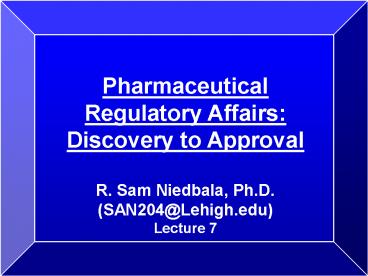Pharmaceutical Regulatory Affairs: Discovery to Approval - PowerPoint PPT Presentation
1 / 20
Title:
Pharmaceutical Regulatory Affairs: Discovery to Approval
Description:
Pharmaceutical Regulatory Affairs: Discovery to Approval R. Sam Niedbala, Ph.D. (SAN204_at_Lehigh.edu) Lecture 7 House Keeping Items House Keeping Items Lecture 7 FDA ... – PowerPoint PPT presentation
Number of Views:1223
Avg rating:5.0/5.0
Title: Pharmaceutical Regulatory Affairs: Discovery to Approval
1
Pharmaceutical Regulatory Affairs Discovery to
Approval R. Sam Niedbala, Ph.D. (SAN204_at_Lehigh.e
du) Lecture 7
2
House Keeping Items
-Selection of Projects by end of September -Exam
1 Update Requirements from Texts other
sources
3
House Keeping Items
1. FDA Regulatory Affairs A Guide for
Prescription Drugs, Medical Devices, and
Biologicsby Douglas J. Pisano (Editor), David
Mantus (Editor) -Exam 1 Chapters 1-4, 7,8 12 2.
Elaine Whitmore, Development of FDA-Regulated
Medical Products -Exam 1 Chapters 1-4 3.
WWW.FDA.gov, CDER Training and Handbook.
Guidelines for Industry
4
Lecture 7
- FDA Medical
- Device Regulations
5
1976 Medical Device Amendments to FDC Act of 1938
6
Summary of Amendment Effects
- By 1978 all new medical devices must be reviewed
by FDA before marketing - Goal is public health
- Recent modifications now include development
process for new products - Regulations reflect differences between devices
and drugs - Anatomy of Medical Device Industry is
dramatically different from Pharmaceuticals - Product life-cycles are 2-3 years
7
Lecture Topics
- Is it a device?
- Medical Device Classification
- Introduction to approval process
- Design Controls
- Medical Device Clinical Research
- 510k premarket notification
- PMA Submissions
- QSRs
- Postmarketing Issues
8
- Is it a device?
- Product Jurisdiction
9
Is It a Device
- Determine which regulations apply
- What is the indication for use?
- Is its action chemical or physical?
10
Is It a Device
- an instrument, apparatus, implement, machine,
contrivance, implant, in vitro reagent, or other
similar or related article, including any
component, part or accessory, which is - Recognized in the official National Formulary, or
the USP, or any supplement to them. - Intended for use in the diagnosis of disease or
other conditions, or in the cure, mitigation,
treatment, or prevention of disease, in man or
other animals, or - Intended to affect the structure of an function
of the body of man or other animals, and which
does not achieve its primary intended purposes
through chemical action within or on the body of
man or other animals and which is not dependent
upon being metabolized for the achievement of any
of its principle intended purposes
11
MDUFA 2002
The office of combination products was also
established in 2002. www.fda.gov/oc/combination
12
Table 7.1 Medical Device Types
13
- Medical Device Classification
- Determining Device Classification
- Reclassification
14
Determining Device Classification
- Class I Pose little risk exempt from 510k
notification to FDA - Class II Pose moderate risk. FDA notification
using 510k is required. Goal is to prove
substantial equivalence to existing product.
Subject to QSRs. Approximately 4000 devices
cleared each year - Class III Require PMA submission and cannot be
shown as substantially equivalent. Issues of
safety may also dictate PMA path. There are 40-50
PMA approvals each year
15
Medical Device Classification
16
Reclassification
- Once a device has been classified it is
difficult to reclassify - Recent history of FDA has demonstrated
willingness to reclassify - Justification is that FDA can then spend time on
high risk areas
17
- Medical Device Approval Process
- Strategic Choices
- Modification of Marketed Devices
18
Strategic Choices
- Device, Classification followed by Strategy
- Medical Devices offer several choices
- Class II to Class III can mean the difference in
90 days to market or 2 years to market - Indication is everything!
- Can regulatory approval create barriers to entry
by competition? - Cost can be one consideration, especially for
smaller companies
19
Medical Device User Fees 2004
20
Modification of Marketed Devices
- 510k Modifications
- New 510k?
- Special 510k
- PMA Modifications
- Requires supplement
- ODE or annual reports































